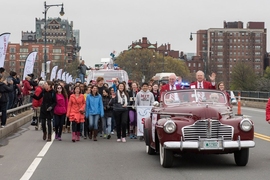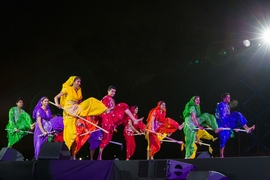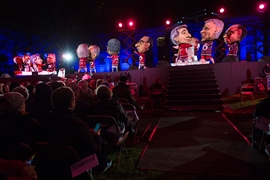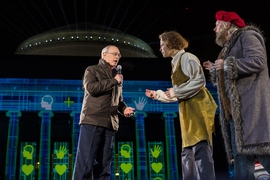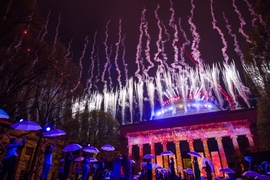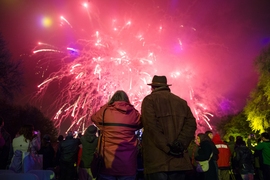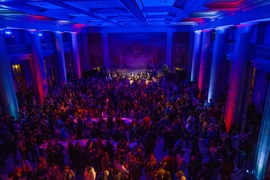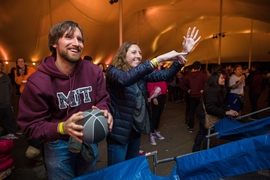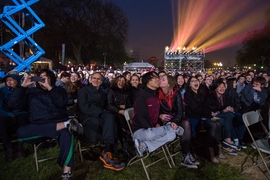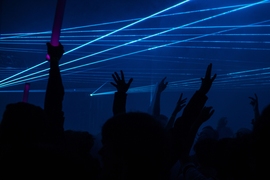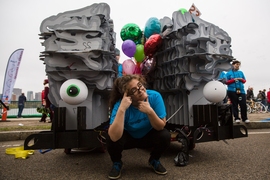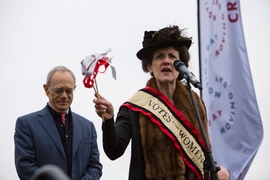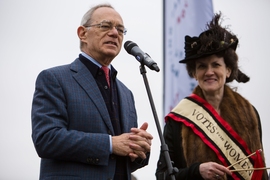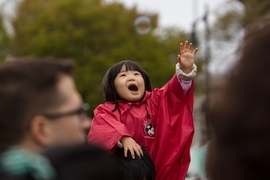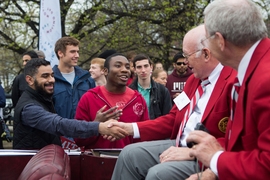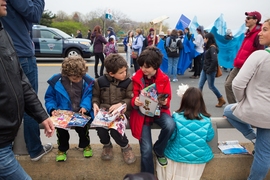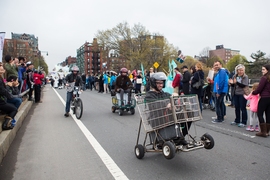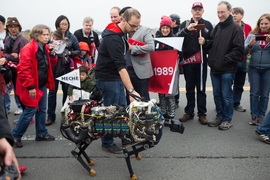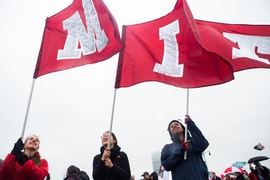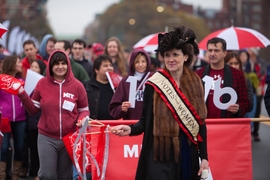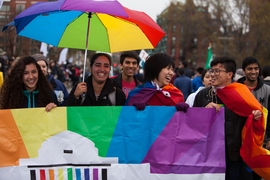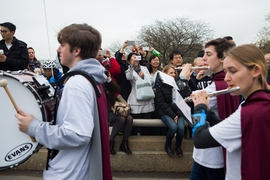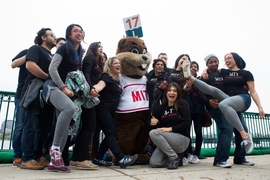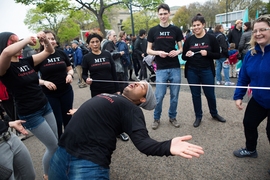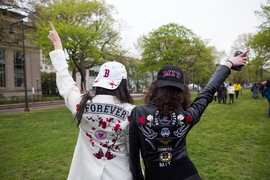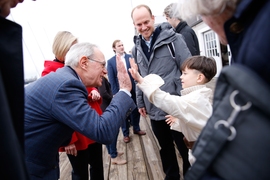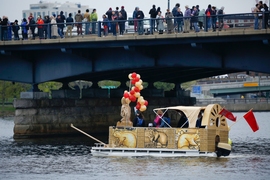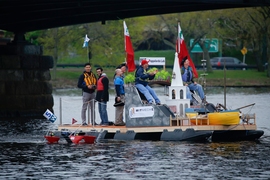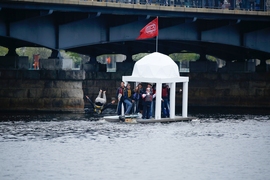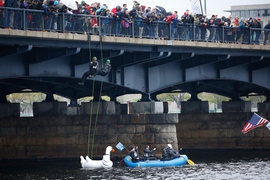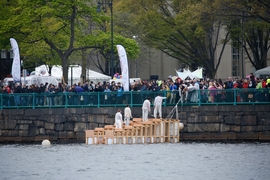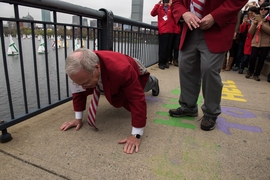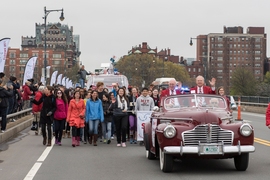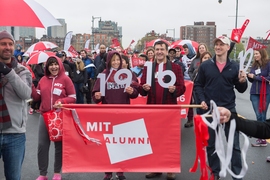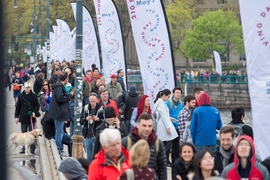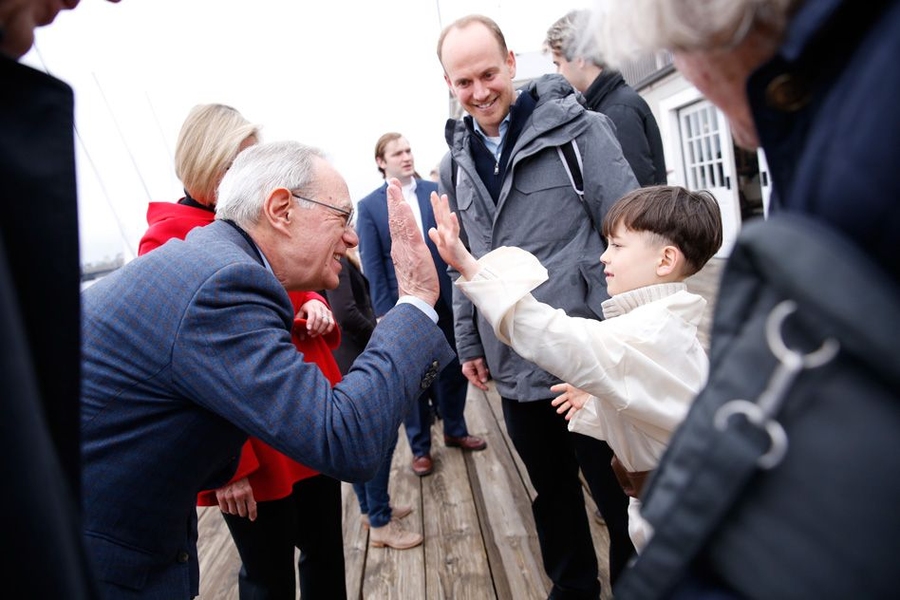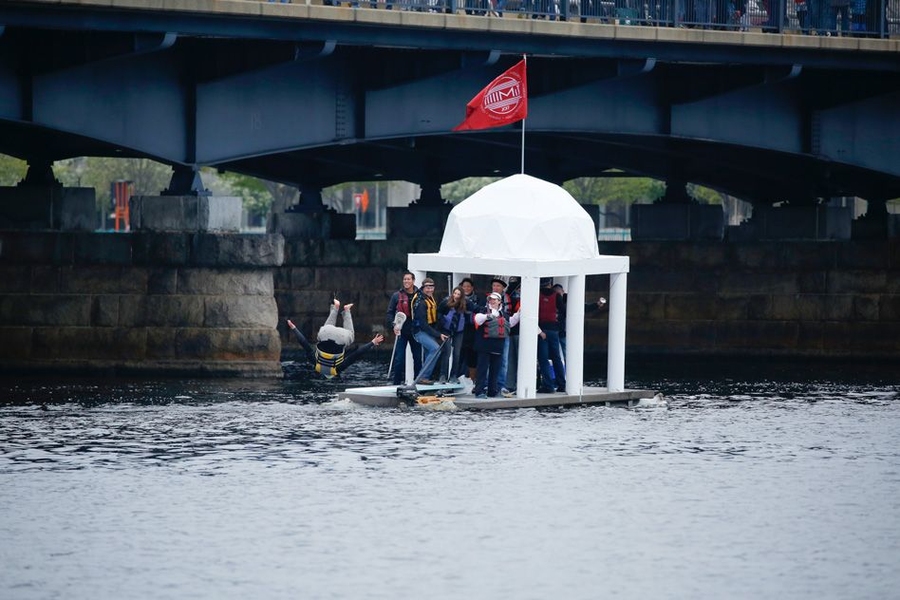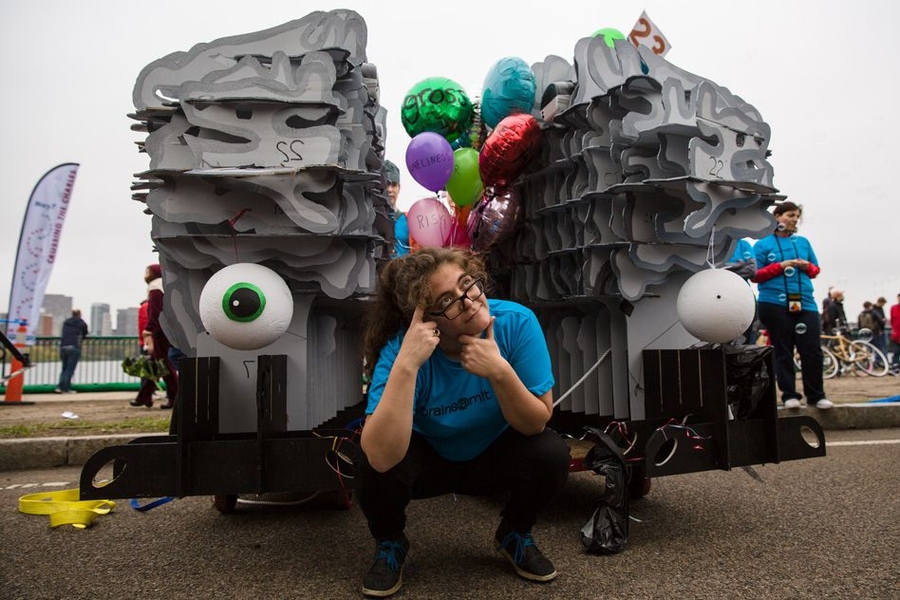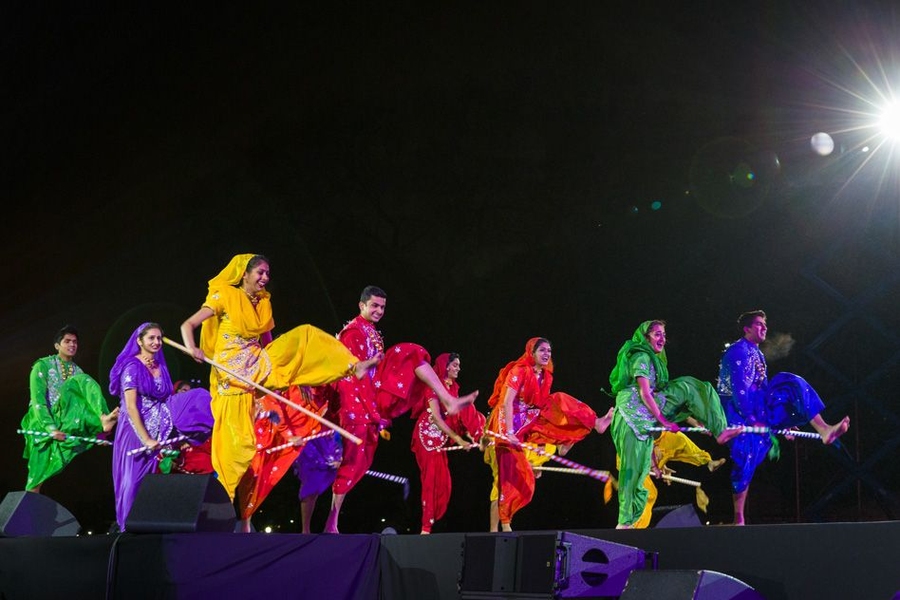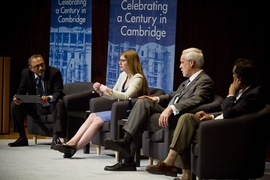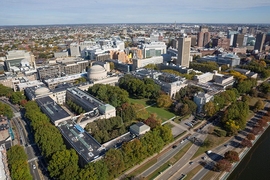They arrived via water and over land, by raft and hydrofoil, on foot and in experimental vehicles. Some paddled. Some danced. Some walked alongside robots. In all, hundreds of members of the MIT community on Saturday celebrated the 100th anniversary of the Institute’s move from Boston into Cambridge, Massachusetts with a unique procession across the Charles River, fueled by humor and creativity.
The “Crossing the Charles” parade and competition, the centerpiece of MIT’s May 7 Moving Day celebrations, took place simultaneously in the water and on the bridge that carries Massachusetts Avenue over the river.
In the river, a festive flotilla of watercraft journeyed across, including an electric hydrofoil craft, a motorized swarm of kayaks, a bamboo raft, and a pedal-powered floating platform in the shape of the dome from MIT’s main building.
Simultaneously, a colorful parade of students, faculty, staff, and alumni — plus a robotic cheetah — marched across the bridge, some with large floats in tow. Neuroscientists transported an 8-foot-high brain model, made out of plywood and set on wheels; MIT Libraries staff carried a fabric “river on sticks,” adorned with books and a laptop; undergraduates guided a “StrandBeaver,” a massive kinetic sculpture; and MIT’s Casino Rueda salsa dancers, a student club, stopped to perform. Hundreds of alumni marched across at the end of the parade.
“The diversity of the MIT community was on full display,” said John Ochsendorf, professor of civil and environmental engineering and architecture, and a faculty co-chair of the event. “You saw it all, from the brain to the bamboo.”
At an award ceremony following the crossing, MIT President L. Rafael Reif said he wanted to “thank the city of Cambridge for their generosity for 100 years” and joked that the city resembled a tolerant host enduring the visit of a long-running house guest.
“We are glad you stayed,” responded Cambridge Mayor Denise Simmons, in remarks following Reif’s comments.
Simmons also called MIT “a blessing and not a burden” and, in the spirit of the day, noted how useful it was to “keep a sense of humor” intact. Nearby, a 30-foot-high replica of a stone megalith bobbed in the river while a mechanical goose sauntered across Memorial Drive.
A noodle raft, a cheetah, and Oliver Smoot, of course
Moving Day, and the parade across the Charles River, was created in homage to MIT’s ceremonial 1916 crossing of the river, when the Institute’s charter was transported across on a barge, the Bucentaur. The 2016 celebration continued into the evening, with a multimedia extravaganza in Killian Court, followed by dance parties around campus whose themes traced 100 years of music and culture.
Moving Day is part of the series of “MIT 2016” celebrations that have been ongoing this year, commemorating MIT’s first century in Cambridge and launching the Institute’s next century of engagement with the world. MIT was founded in 1861, in Boston, before relocating to the Kendall Square area of Cambridge.
The idea behind the river-crossing event was to “let people do whatever they want and express their technical creativity,” said Annette Hosoi, a professor of mechanical engineering, and the other faculty co-chair of the event. “And people responded — really the whole community.”
Indeed, the parade and competition consisted of 26 entries on the water and 28 groups crossing the bridge. The more conventional water entries included boats from the MIT varsity sailing team and star rower Veronica Toro ’16, an Olympic hopeful. There were also folding kayaks, a “noodle raft” lashed together from pool noodles and kickboards, and a jet-powered boat from MIT’s International Design Center.
“All the watercraft stayed afloat,” Ochsendorf noted approvingly.
(For the record: Participants wore lifejackets and safety personnel were on hand.)
Up on the bridge, members of MIT’s Emergency Medical Services drove an ambulance that is dedicated to the memory of MIT police officer Sean Collier, while experimental vehicles of all kinds dotted the parade. MIT students and alumni demonstrated an aluminum-powered car, cutting-edge wheelchair designs, and a bamboo bicycle, among other entries.
Meanwhile MIT’s robotic cheetah, which can run at over 13 miles per hour, strolled across at a leisurely pace.
The parade’s grand marshal was Oliver Smoot ’62, a familiar name in local lore. As multitudes of area runners and walkers have noticed, the sidewalk over the bridge is marked in increments of “Smoots” — after a 1958 MIT prank in which Smoot’s friends got him to lie down, repeatedly, until they had crossed the entire bridge. For the record, Smoot is 5 feet 7 inches tall, and the bridge is 364.4 Smoots long.
Before the parade, Smoot reenacted lying down on the bridge’s sidewalk but noted that it had been easier for him to do so as an undergraduate. “We were faster and lighter then,” he joked.
Awards gala
A panel of six members of the MIT administration serving as judges gave out four awards to the participants, after what MIT Provost Martin A. Schmidt termed “careful deliberation.”
Brain researchers from three different MIT institutes and departments won the soon-to-be-prestigious Da Vinci Award, given for “creativity and wonder,” for their supersized brain model. Students from Course 4.302 (Foundations in Arts, Design and Spatial Practices) took home the Bosworth Award for “beauty and elegant design,” for their large zooplankton-motif structure, “Time Spirit and the Masquerade of Power,” which also featured printed images from MIT’s campus and history.
Researchers from MIT’s Pappalardo Lab won the Tech Pioneer Award for the “most innovative” craft in the flotilla; they transformed an obstacle course for robots from Course 2.007 (Design and Manufacturing) into a floating vessel. And the MIT Libraries team won the Beaver Spirit Award for the entry best exemplifying school spirit.
The brain researchers’ team, led by Julie Pryor of the McGovern Institute for Brain Research, built their float over two months, with 50 people participating. The plywood vehicle, called “A Beautiful Mind,” consists of 22 coronal “slices” of the brain, based on the personal data of team member Rosa Lafer-Sousa, a researcher in the Department of Brain and Cognitive Sciences (BCS).
Ben Bartelle, also of BCS, personally cut the plywood slices at MIT’s hobby shop.
“We’re MRI people,” Bartelle told MIT News. “We see slices like that all the time.”
So what is it like to see a giant plywood replica of one’s brain, on wheels, crossing the bridge over the Charles River?
“It’s pretty special,” Lafer-Sousa acknowledged. “I couldn’t sleep last night. It felt a little like Christmas.”
Mens, manus, cor: A spectacle on Killian Court
As dusk later fell over the Institute, several thousand students, faculty, staff, and friends filed into MIT’s Killian Court to witness a spectacular pageant of singing, dancing, computer art, and the embodiment of the MIT spirit.
With an illuminated MIT dome serving as a beacon for anyone within eyeshot, the event began with a procession of students bearing oars, a symbol of the 1916 river-crossing, and a parade of drummers welcoming onlookers to the fête.
Over the next hour, characters representing the living spirits of MIT’s motto, “mens et manus” (“mind and hand”) — and the two individuals on the MIT seal — guided the audience through the story of MIT from its humble beginnings in Boston through the Institute’s move to Cambridge a century ago and into the present. “Mens,” representing the theoretical, scientific, humanistic elements of MIT life, and “Manus,” representing the practical applications of these disciplines, spatted over what they thought was the most important aspect of life at MIT: theory or practice.
The two took turns making their case, bringing out, for example, human-sized bobbleheads featuring some of the most noted MIT faculty and alumni from each “side” of the mind-or-hand debate and recounting successes over the previous century — from the 19th-century application of chemical engineering to the new science of home economics by Ellen Swallow Richards to the 2015 detection of gravitational waves led by MIT Professor Emeritus Rainer Weiss. Guided by a robot voiced by MIT alumnus and “Car Talk” host Ray Magliozzi, the duo eventually realized that only with both mind and hand working in unison — and with the addition of “cor,” or “heart” — could MIT have developed into the thriving institution it is today.
Appropriately for the day’s weather — which had a distinctly wintry feel, with chilly temperatures, a brisk wind, and some rain — the event’s finale featured an undulating umbrella dance, which led, finally, into an impressive fireworks display over the Charles River. When it was all over, a roar of applause and hooting filled Killian Court, as attendees grabbed their own umbrellas and made their way to various dance parties hosted across the Institute to cap the day’s festivities.
Oliver Smoot, who has retired to Southern California, noted that he, for one, wasn’t bothered by the elements. “It’s all been great,” he said. And his friend Peter Miller ’62, who rode with Smoot in the grand marshal’s car during the afternoon parade, explained how he had ignored the cold: “From the warmth of all the people waving, and watching, and jumping up and down.”
Maia Weinstock contributed to this story.
